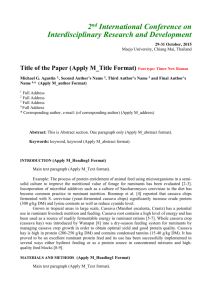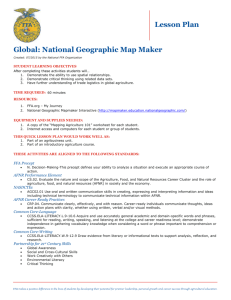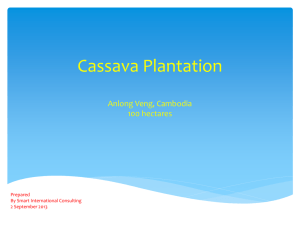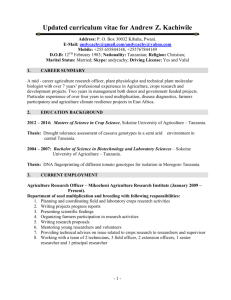Guidelines for completion of pro-forma for best-bet
advertisement
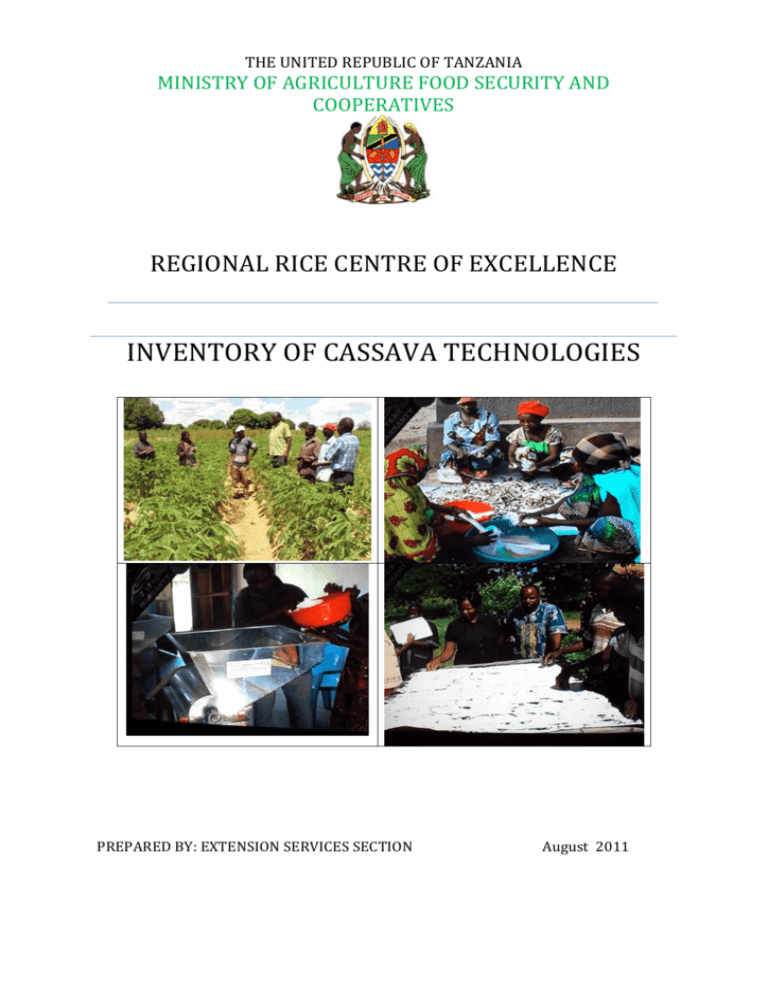
THE UNITED REPUBLIC OF TANZANIA MINISTRY OF AGRICULTURE FOOD SECURITY AND COOPERATIVES REGIONAL RICE CENTRE OF EXCELLENCE INVENTORY OF CASSAVA TECHNOLOGIES PREPARED BY: EXTENSION SERVICES SECTION August 2011 Introduction This inventory includes Cassava technologies and good agricultural practices of Cassava crop along the value chain documented from different sites in the country. The sites include research stations of Naliendele ( Mtwara Region), Ukiruguru( Mwanza) and Kibaha( coast region). Inventory of technologies was also carried out to farmers groups in Villages namely (Msijute villages,Mango pachanne,Mbawala) in Mtwara District Council, Mahita village inTandahimba District Council, Mtangalanga in Newala Ditrict Mtwara region (Southern Zone) Ngo’mbe in Misungwi District Mwanza, Kitalamaka Bunda District Council Mara Region( Lake Zone) and Sululu in Rufiji District Coast Region (Eastern zone) The inventory was done using a guideline provided by ASARECA that required the following for each technology or good practice: i. Clear elaboration / description of the technology or practice ii. Problem it aims to address in response to commodity challenges iii. Have a proven record that it has been tested, adapted and utilized by beneficiaries iv. Areas it has been promoted (ecological factors) v. Generators, promoters and users of the technology vi. Essential factors for successful promotion and adoption vii. Challenges (if any) for further dissemination /up or out scaling viii. Recommendations for addressing listed challenges ix. Lessons learnt on best ways to get the technologies to the largest number of people x. Gender issues (if any) considered in the development and dissemination of the technology and xi. Any additional information considered important about the technology and its promotion Table Shows the Areas Visited ZONE DISTRICT Southern Zone Mtwara DC AREA VISITED Msijute village Mangopacha Nne village Mbawala village Tandahimba Mahuta village Lake Zone Newala DC Mtangalanga Misungwi DC Ng’ombe Bunda DC Eastern Zone Rufiji DC Mwakalima village Kitalamaka village Sululu Village FARMER/GROUP TECHNOLOGY Mkombozi Farmer group Somo Farmer Group Jitegemee Farmer Group Ukombozi Farmers Group Muungano Farmers Group Farmer Power tiller Spacing Seed multiplication Cassava processing Cassava processing Cassava processing Seed multiplication Seed Multiplic Maendeleo Farmer Seed Multiplication Group Ukombozi Farmer Seed Multiplication Group Sululu Cassava Processing Farmer Group 2 . 1. Title of the technology or innovation Spacing 2. Description of the technology or innovation ⇒ Spacing is generally described as a row to row or plant to plant distance or planting pattern. Researchers have recommended a space of 1x1m. ⇒ For maximum root production cassava is usually planted at a population of 10,000 plants/ha stakes are generally planted at 1x1. m for monoculture cassava or at wider row spacing (up to 2 m between rows) for intercropping The technology aims in addressing the problem of under population/overpopulation of plants in the field thus give the farmer optimum yields. 3. Contact details of the generators and promoters of the technology/innovation. Name and contact address of the organisation: ARI Naliendele (Generator) Email address: utafiti@iwayafrica.com Telephone: +255(073)2934035 Fax:+255(073)2934103 P.O BOX 509-Mtwara Country: Tanzania Name and contact address of key scientist: PO Box: 509 Email address: geoffreymkamilo@yahoo.co.uk Telephone: +255(073)2934035 Fax:+255(073)2934103 Mobile: 0784 795389 Country: TANZANIA Name and contact address of key partners: PO Box: 1433 ARI- Ukiriguru Mwanza Email address: lzalde@iwayafrica.com/ januarimafuru@yahoo.com Telephone: 0732981065/0732980768 Fax: Nil Mobile: 0756-657316 Country: TANZANIA P.O BOX 30031 Kibaha Sugar cane Telphone: 0732-932373 Email: isacterus_2000@yahoo.com Country: TANZANIA 3 4. Users of the technology/innovation ⇒ Cassava growers ⇒ Training and research institutions like ARI Naliendele, IITA etc for research and training purposes 5. Critical and essential factors for successful promotion and adoption of the technology/innovation ⇒ Capacity building and establishment of demonstration plots on practice of 1x1m spacing ⇒ Awareness creation to farmers on the benefits associated with the technology 6. Challenges encountered in respect to further dissemination of the technology/innovation, adoption and up/out scaling ⇒ Low technical knowledge to beneficiaries/farmer on the benefits of the technology 6. Recommendation for addressing the challenges listed in number ⇒ Capacity building to farmers and practice the technology through Farmer field school. 7. Lessons learnt about the best ways to get the technology used by the largest number of people. ⇒ Farmer field school is a best way /approach to disseminate the technologies ⇒ Farmer to farmer extension should be encouraged ⇒ Regular training to key farmers and study tour 8. Gender issues/concerns considered in the development and dissemination of the technology Both men are equally involved 4 9. Additional important information about the technology and its promotion in the region Picture showing cassava planted in recommended spacing 1. Title of the technology or innovation Kachaga- Cassava improved seeds 2. Description of the technology or innovation being proposed ⇒ Kachaga is one of the cassava improved seed variety. Kachaga is characterices by; i. Early maturity (harvesting 8months), ii. High yielding 12-17 tons/hectare while local varieties are yielding 5-10 tons/hectare, iii. Bitter and diseases /pest tolerant. ⇒ The technology aimed in addressing unavailability of planting materials, Diseases and pest attack and Low yield per unit area. 5 3. Contact details of the generators and promoters of the technology/innovation Name and contact address of the organisation: ARI Ukiriguru (Generator) Email address: izalde@iwayafrica.com/januarimafuru@yahoo.com Telephone: 0732981065/9732980768 Fax:Nil Mobile: 0756-657316 P.O BOX 1433-Mwanza Country: Tanzania Name and contact address of key scientist: PO Box: 509 Email address: geoffreymkamilo@yahoo.co.uk Telephone: +255(073)2934035 Fax:+255(073)2934103 Mobile: 0784 795389 Country: TANZANIA Name and contact address of key partners: PO Box: 509 ARI- Naliendele Mtwara Email address: utafiti@iwayafrica.com Telephone: +255(073)2934035 Mobile: 0784795389 Country: TANZANIA P.O BOX 30031 Kibaha Sugar cane Telphone: 0732-932373 Email: isacterus_2000@yahoo.com Country: TANZANIA Fax: +255(073)2934103 4. The users of the technology/innovation ⇒ Individual cassava farmers ⇒ Researchers and research institutions 5. The critical and essential factors for successful promotion and adoption of the technology/innovation ⇒ Availability of enough planting materials (seeds) ⇒ Capacity building on improved varieties and agronomic practices ⇒ Access to credits and incentives ⇒ Improved marketing systems for cassava and the associated products 6 6. Challenges encountered in respect to further dissemination of the technology/innovation, adoption and up/out scaling ⇒ Low multiplication ratio of planting materials – presently at the ratio of 1:10 Inadequate supply of improved planting materials, ⇒ Myths on cassava crop as it is regarded to be an inferior crop in some places ⇒ Low investment on seed production 7. Recommendation for addressing the challenges listed in number 6 above. ⇒ To have in place a clear policy which address cassava promotion (especially blending cassava flour with other cereals) ⇒ Heavy investment on cassava seed multiplication and more emphasis should put on commodity based seed multiplication systems ⇒ Promote cassava from being a draught and food crop to cash crop 8. Lessons learnt about the best ways to get technologies or innovations used by the largest number of people ⇒ Farmers should be involved in the process of the technology dissemination – Participatory approach 9. Gender issues /concerns considered in the development and dissemination of the technology or innovation ⇒ Both women and men involved equally in the production of cassava 10. Additional information that you might consider important about the technology/innovation and its promotion in the region. ⇒ Private sector should be involved in promoting and production of cassava improved seed on commercial basis 7 1. Title of the technology or innovation Mkombozi - Cassava improved seeds 2. Description of the technology or innovation being proposed ⇒ Mkombozi is one of the cassava improved seed. Mkombozi is characterized by: i. Early maturity ( harvesting 8 months), ii. High yielding 12-17 tons/hectare compared to local variety which yield 5-10 tons/hectare, iii. Sweet and diseases /pest tolerant ⇒ The technology aimed to address unavailability of planting materials, diseases and pest attack and Low yield per unit area 3. Contact details of the generators and promoters of the technology/innovation. Name and contact address of the organisation: ARI Ukiriguru (Generator) Email address: izalde@iwayafrica.com/januarimafuru@yahoo.com Telephone: o732981065/0732980768 Fax: Nil Mobile: 0756-657316 P.O BOX 1433-Mwanza Country: Tanzania Name and contact address of key scientist: PO Box: 509 Email address: geoffreymkamilo@yahoo.co.uk Telephone: +255(073)2934035 Fax:+255(073)2934103 Mobile: 0784 795389 Country: TANZANIA Name and contact address of key partners: PO Box: 509 ARI- Naliendele Mtwara Email address: utafiti@iwayafrica.com Telephone: +255(073)2934035 Mobile: 0784795389 Country: TANZANIA P.O BOX 30031 Kibaha Sugar cane Telphone: 0732-932373 Email: isacterus_2000@yahoo.com Country: TANZANIA Fax: +255(073)2934103 4. The users of the technology/innovation ⇒ The technology is used by farmers growing cassava, researchers, research and training institutions 8 5. The critical and essential factors for successful promotion and adoption of the technology/innovation ⇒ Availability of enough planting materials (seeds) ⇒ Capacity building on improved varieties and agronomic practices ⇒ Access to credits and incentives ⇒ Improved marketing systems for cassava and the associated products 6. Challenges encountered in respect to further dissemination of the technology/innovation, adoption and up/out scaling ⇒ Low multiplication ratio of planting materials – presently at the ratio of 1:10 Inadequate supply of improved planting materials, ⇒ Myths on cassava crop as it is regarded to be an inferior crop in some places ⇒ Low investment on seed production 7. Recommendation for addressing the challenges listed in number 6 above. ⇒ To have in place a clear policy which address cassava promotion (especially blending cassava flour with other cereals) ⇒ Heavy investment on cassava seed multiplication and more emphasis should put on commodity based seed multiplication systems ⇒ Promote cassava from being a draught and food crop to cash crop 8. Lessons learnt about the best ways to get technologies or innovations used by the largest number of people ⇒ Farmers should be involved in the process of the technology dissemination – Participatory approach 9. Gender issues /concerns considered in the development and dissemination of the technology or innovation ⇒ Both women and men involved equally in the production of cassava 9 10. Additional information considered important technology/innovation and its promotion in the region about the ⇒ Private sector should be involved in promoting and production of cassava improved seed on commercial basis Extension staff, researchers and farmers assesing growth of Mkombozi variety 1. Title of the technology or innovation Kiroba- Cassava improved seeds 2. Description of the technology or innovation being proposed ⇒ Kiroba is one of the cassava improved seed. Kiroba is characterized by: i. Early maturity ( harvesting 8 months), ii. High yielding 20 tons/hectare compared to local variety which yield 5 - 8 tons/hectare, iii. Sweet and diseases /pest tolerant ⇒ The technology aimed to address unavailability of planting materials, diseases and pest attack and Low yield per unit area 10 3. Contact details of technology/innovation. the generators and promoters of the Name and contact address of the organisation: Kibaha Sugar cane Institute (Generator) Email address: isacterus_2000@yahoo.com Telephone: 0732 932373 Fax: P.O BOX 3003-Kibaha Country: Tanzania Name and contact address of key scientist: PO Box: 509 Email address: geoffreymkamilo@yahoo.co.uk Telephone: +255(073)2934035 Fax:+255(073)2934103 Mobile:0784 795389 Country: TANZANIA Name and contact address of key partners: PO Box: 1433 ARI- Ukiriguru Mwanza Email address: lzalde@iwayafrica.com/ januarimafuru@yahoo.com Telephone: 0732981065/0732980768 Fax: Nil Mobile:0756-657316 Country: TANZANIA P.O BOX 509 ARI- Naliendele-Mtwara Telphone:+255(073)2934035 FAX: +255(073)2934103 Email: utafiti@iwayafrica.com Country: TANZANIA 4. Users of the technology/innovation ⇒ The technology is used by farmers growing cassava, researchers, research and training institutions 5. The critical and essential factors for successful promotion and adoption of the technology/innovation ⇒ Availability of enough planting materials (seeds) ⇒ Capacity building on improved varieties and agronomic practices ⇒ Access to credits and incentives ⇒ Improved marketing systems for cassava and the associated products 6. Challenges encountered in respect to further dissemination of the technology/innovation, adoption and up/out scaling ⇒ Low multiplication ratio of planting materials – presently at the ratio of 1:10 Inadequate supply of improved planting materials, ⇒ Myths on cassava crop as it is regarded to be an inferior crop in some places ⇒ Low investment on seed production 11 7. Recommendation for addressing the challenges listed in number 6 above. ⇒ To have in place a clear policy which address cassava promotion (especially blending cassava flour with other cereals) ⇒ Heavy investment on cassava seed multiplication and more emphasis should put on commodity based seed multiplication systems ⇒ Promote cassava from being a draught and food crop to cash crop 8. The lessons learnt about the best ways to get technologies or innovations used by the largest number of people ⇒ Farmers should be involved in the process of the technology dissemination – Participatory approach 9. Gender issues /concerns considered in the development and dissemination of the technology or innovation ⇒ Both women and men involved equally in the production of cassava 11. Additional information that you might consider important about the technology/innovation and its promotion in the region. ⇒ Private sector should be involved in promoting and production of cassava improved seed on commercial basis Kiroba variety grown at Mangopachanne village at Mtwara District 12 1. Title of the technology or innovation Naliendele - Cassava improved seeds 2. Description of the technology or innovation being proposed ⇒ Naliendele is one of the cassava improved seed. Naliendele is characterized by: iv. Early maturity ( harvesting 8 – 12 months), v. High yielding 20 tons/hectare compared to local variety which yield 5 - 8 tons/hectare, vi. Sweet and diseases /pest tolerant ⇒ The technology aimed to address unavailability of planting materials, diseases and pest attack and Low yield per unit area 3. Contact details of the generators and promoters technology/innovation. Contact details of generators and promotors of technology/innoation of the Name and contact address of the organisation: ARI Naliendele (Generator) Email address: utafiti@iwayafrica.com Telephone: +255(073)2934035 Fax:+255(073)2934103 P.O BOX 509-Mtwara Country: Tanzania Name and contact address of key scientist: PO Box: 509 Email address: geoffreymkamilo@yahoo.co.uk Telephone: +255(073)2934035 Fax:+255(073)2934103 Mobile: 0784 795389 Country: TANZANIA Name and contact address of key partners: PO Box: 1433 ARI- Ukiriguru Mwanza Email address: lzalde@iwayafrica.com/ januarimafuru@yahoo.com Telephone: 0732981065/0732980768 Fax: Nil Mobile: 0756-657316 Country: TANZANIA P.O BOX 30031 Kibaha Sugar cane Telphone: 0732-932373 Email: isacterus_2000@yahoo.com Country: TANZANIA 4. The users of the technology/innovation ⇒ The technology is used by farmers growing cassava, researchers, research and training institutions 13 5. The critical and essential factors for successful promotion and adoption of the technology/innovation ⇒ Availability of enough planting materials (seeds) ⇒ Capacity building on improved varieties and agronomic practices ⇒ Access to credits and incentives ⇒ Improved marketing systems for cassava and the associated products 6. The challenges encountered in respect to further dissemination of the technology/innovation, adoption and up/out scaling ⇒ Low multiplication ratio of planting materials – presently at the ratio of 1:10 Inadequate supply of improved planting materials, ⇒ Myths on cassava crop as it is regarded to be an inferior crop in some places ⇒ Low investment on seed production 7. Recommendation for addressing the challenges listed in number 6 above. ⇒ To have in place a clear policy which address cassava promotion (especially blending cassava flour with other cereals) ⇒ Heavy investment on cassava seed multiplication and more emphasis should put on commodity based seed multiplication systems ⇒ Promote cassava from being a draught and food crop to cash crop 8. Lessons learnt about the best ways to get technologies or innovations used by the largest number of people ⇒ Farmers should be involved in the process of the technology dissemination – Participatory approach 9. Gender issues /concerns considered in the development and dissemination of the technology or innovation ⇒ Both women and men involved equally in the production of cassava 10. Additional information to consider important technology/innovation and its promotion in the region. about the ⇒ Private sector should be involved in promoting and production of cassava improved seed on commercial basis 14 1. Title of the technology or innovation Manual and powered cassava grater and chipper 2. Description of technology/innovation The manual and powered grater and chipper are used to prepare cassava flour out of fresh cassava. The technology aims at reducing post harvesting losses on cassava and other tuber crops. Cassava roots are peeled immediately after harvesting. The peeled roots are washed to remove dirt and pieces of peels. Peeled roots are next chipped, grated, sliced, cubed or pelleted before further processing can take place.If the chips come from bitter cassava varieties, the roots are often kept in water for 2 to 4 days. This allows hydrogen cyanide to be released, reducing any public health hazard. The water must be carefully disposed of afterwards. Chipping can be done manually or with chipping equipment. Cassava chips has to be dried to a moisture content of around 12 to 15% from the original moisture content of 65 to 75%. Once dried the chips should break easily without crumbling. If no other storage method is used drying should take place within 2 days of harvesting to ensure that the quality of the product is maintained. Cassava chips are often infested by insects during the drying process so the time taken to dry the chips is important. The drying process can be shortened by increasing the surface area of the chips in relation to their volume - so the smaller the chips the faster the drying time. Traditionally cassava has been sun dried in the open air, either on the ground or on a raised platform. If cassava is grated or rasped as part of its processing then cassava paste need to be dewatered, this can remove up to 50% of the water. Dewatering process can be done by various types of press. The more simple types consist of parallel press boards that can be screwed together. The paste is put into hessian or polypropylene sacks and placed into the press. Cassava grits have to be dried to moisture content of around 12 to 15%; from the original moisture content of 65 to 75% on sun in the open air, on a raised platform. Once dried the grits should be packed into polythene bags to prevent any moisture being absorbed from the air. The bags should then be stored in a cool dry location or can be milled to flour, packaging and stored in a dry and clean place 3. Contact details of technology/innovation. the generators and promoters of the Name and contact address of the organisation: ARI Naliendele (Generator) Email address: utafiti@iwayafrica.com Telephone: +255(073)2934035 Fax:+255(073)2934103 P.O BOX 509-Mtwara Country: Tanzania Name and contact address of key scientist: PO Box: 509 Email address: geoffreymkamilo@yahoo.co.uk Telephone: +255(073)2934035 Fax:+255(073)2934103 Mobile: 0784 795389 Country: TANZANIA Name and contact address of key partners: PO Box: 1433 ARI- Ukiriguru Mwanza Email address: lzalde@iwayafrica.com/ januarimafuru@yahoo.com Telephone: 0732981065/0732980768 Fax: Nil Mobile: 0756-657316 Country: TANZANIA P.O BOX 30031 Kibaha Sugar cane Telphone: 0732-932373 Email: isacterus_2000@yahoo.com Country: TANZANIA 15 4. The users of the technology/innovation ⇒ The technology is used by farmers growing cassava, researchers, research and training institutions and cassava processors for commercial purposes 5. Critical and essential factors for successful promotion and adoption of the technology/innovation ⇒ Most farmer and processor are still new into the technology hence more training and technology dissemination is needed ⇒ Capacity building in terms of accessing credits and incentives ⇒ Improved marketing systems for cassava and the associated products 6. The challenges encountered in respect to further dissemination of the technology/innovation, adoption and up/out scaling ⇒ Low quality of cassava flour and associated products which do not attract consumers ⇒ Low price of cassava products compared to production costs ⇒ In some places cassava is not considered as a commercial produce 7. Recommendation for addressing the challenges listed in number 6 above. ⇒ To have in place a clear policy which address cassava promotion (especially blending cassava flour with other cereals) ⇒ Promote cassava from being a draught and food crop to cash crop 8. Lessons learnt about the best ways to get technologies or innovations used by the largest number of people ⇒ To avoid top down approach and to involve farmers on decision making on which type of technology they do prefer 9. Gender issues /concerns considered in dissemination of the technology or innovation the development and ⇒ Both women and men involved on operating the processing machine but in some places women are timid 16 10. Additional information to consider important technology/innovation and its promotion in the region. about the ⇒ Private sector should be involved in promoting, production and processing of cassava and the associated products Manual peeling of cassava Cassava Grating and Rasping Dewatering using hydraulic jack Drying on the raised platform 17


